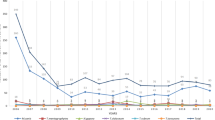Abstract
This survey was a retrospective of a 16-year (1993–2008) study on the incidence, clinical features, and etiological agents of tinea capitis mainly representing the Southeastern China. The diagnosis was confirmed by direct microscopic examination. Eight hundred and sixty-six patients with tinea capitis, 381 males (44%) and 485 females (56%), were enrolled in this study. Patients were between 20 days and 84 years old with an average of 10.5 years and the peak incidence was in the age group of 6–10 (48.5%). Five hundred and sixty-two patients (64.9%) were ectothrix and 303 patients (35.0%) were endothrix with only one patient was favus. The incidence of tinea capitis from 1993 was gradually increasing and reaching to its peak in 2001. Positive cultures of dermatophytes were obtained in 715 patients: Microsporum canis (62.4%) was predominant, followed by Trichophyton violaceum (19.0%), Trichophyton tousurans (9.8%). M. canis was the major pathogen for ectothrix infection, while T. violaceum and T. tousurans contributed to the most endothrix form. M. canis, T. violaceum, and T. rubrum were the major pathogens for kerion.

Similar content being viewed by others
References
Sberna F, Farella V, Geti V, et al. Epidemiology of the dermatophytoses in the Florence area of Italy: 1985–1990. Trichophyton mentagrophytes, Epidermophyton floccosum and Microsporum gypseum infections. Mycopathologia. 1993;122:153–62.
Sobera JO, Elewski BE. In: Bolognia JL, editor. Dermatology, 2nd ed. London: Mosby 2008; p. 1141.
Seebacher C, Abeck D, Brasch J, et al. Tinea capitis: ringworm of the scalp. Mycoses. 2007;50:218–26.
Dolenc-Voljc M. Dermatophyte infections in the Ljubljana region, Slovenia, 1995–2002. Mycoses. 2005;48:181–6.
Romano C. Tinea capitis in Siena, Italy. An 18-year survey. Mycoses. 1999;42:559–62.
Prohic A. An epidemiological survey of tinea capitis in Sarajevo, Bosnia and Herzegovina over a 10-year period. Mycoses. 2008;51:161–4.
Elewski BE. Tinea capitis: a current perspective. J Am Acad Dermatol. 2000;42:1–20.
Gupta AK, Summerbell RC. Increased incidence of Trichophyton tonsurans tinea capitis in Ontario, Canada between 1985 and 1996. Med Mycol. 1998;36:55–60.
Leeming JG, Elliott TS. The emergence of Trichophyton tonsurans tinea capitis in Birmingham, U.K. Br J Dermatol. 1995;133:929–31.
Sugita T, Shiraki Y, Hiruma M. Genotype analysis of the variable internal repeat region in the rRNA gene of Trichophyton tonsurans isolated from Japanese Judo practitioners. Microbiol Immunol. 2006;50:57–60.
Fuller LC. Changing face of tinea capitis in Europe. Curr Opin Infect Dis. 2009;22:115–8.
Deng S, Bulmer GS, Summerbell RC, et al. Changes in frequency of agents of tinea capitis in school children from Western China suggest slow migration rates in dermatophytes. Med Mycol. 2008;46:421–7.
Moraes MS, Godoy-Martínez P, Alchorne MM, et al. Incidence of Tinea capitis in São Paulo, Brazil. Mycopathologia. 2006;162:91–5.
Ayaya SO, Kamar KK, Kakai R. Aetiology of tinea capitis in school children. East Afr Med J. 2001;78:531–5.
Jha BN, Garg VK, Agrawal S, et al. Tinea capitis in eastern Nepal. Int J Dermatol. 2006;45:100–2.
Jahromi ShB, Khaksar AA. Aetiological agents of tinea capitis in Tehran (Iran). Mycoses. 2006;49:65–7.
Mohsin MS, Della C, Titos PB. Tinea capitis among rural school children of the district of Magude, in Maputo province, Mozambique. Mycoses. 2006;49:480–3.
Grills CE, Bryan PL, O’Moore E, et al. Microsporum canis: report of a primary school outbreak. Australas J Dermatol. 2007;48:88–90.
Author information
Authors and Affiliations
Corresponding author
Additional information
Min Zhu and Li Li have contributed equally to this paper.
Rights and permissions
About this article
Cite this article
Zhu, M., Li, L., Wang, J. et al. Tinea Capitis in Southeastern China: A 16-Year Survey. Mycopathologia 169, 235–239 (2010). https://doi.org/10.1007/s11046-009-9260-2
Received:
Accepted:
Published:
Issue Date:
DOI: https://doi.org/10.1007/s11046-009-9260-2




